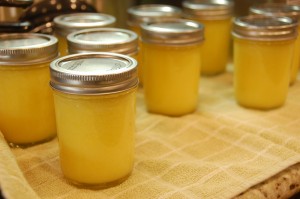 Lemon Curd (or Lime Curd) is a very versatile “fruit spread”. You can use it as an alternative to jam or jelly, as a cake or pie filling, or as a custard-like topping to spoon over desserts. It has a wonderful tart (yet sweet) flavor, and is thick and rich. I like to use lemon curd as a topping on cheesecake, as a filling in lemon thumbprint cookies, or as a sauce to serve over a “last-minute dessert” of pound cake and vanilla ice cream. Or, try my recipe for these cute flower shaped mini lemon tarts.
Lemon Curd (or Lime Curd) is a very versatile “fruit spread”. You can use it as an alternative to jam or jelly, as a cake or pie filling, or as a custard-like topping to spoon over desserts. It has a wonderful tart (yet sweet) flavor, and is thick and rich. I like to use lemon curd as a topping on cheesecake, as a filling in lemon thumbprint cookies, or as a sauce to serve over a “last-minute dessert” of pound cake and vanilla ice cream. Or, try my recipe for these cute flower shaped mini lemon tarts.
This recipe is based on the National Center for Home Food Preservation’s “safe” recipe for home canned lemon curd, published by the University of Georgia. They recommend using bottled juice (for consistent acidity) – but bottled juice is yucky!!! I use fresh lime or lemon instead, and make sure to use varieties that are high in acidity for safety. If you are uncertain about the acid content of your limes or lemons, it’s safer to used the bottled juice. (This recipe can be cut in half.)
You can also use this recipe to make orange or tangerine curd, but the acid content is too low for safe home-canning. If you make orange or tangerine curd, make sure to use it right away, or store in the freezer.
- zest of 14 limes (or zest of 10 lemons)
- 2 c. lime or lemon juice (about 14 limes or 10 lemons)
- 8 whole eggs
- 14 egg yolks
- 2 tsp. salt
- 5 c. sugar
- 1 1/2 c. unsalted butter, melted
Hardware:
- large stock pot with metal rack
- 9 half-pint canning jars with rings and new lids
- tongs
- double boiler, or a large stock pot & metal bowl
- instant read thermometer
1. Thoroughly wash and scrub the limes, then dry with a paper towel. Using a citrus zester (or grater if you don’t have a zester), remove the zest from the limes, avoiding the bitter white pith.
2. Cut the limes in half, and juice. You will need 2 cups of lime juice total.
3. Heat up your double boiler, or you can do what I do and place a large metal bowl over a pot of simmering water. Add the sugar, whole eggs, egg yolks, salt, and lime zest. Mix thoroughly with a whisk.
4. As you continue whisking, add the lime juice. Then add the melted butter. (Wear oven mitts while doing this for safety) Continue cooking the mixture slowly over the simmering water, while whisking. Check with the thermometer regularly. Once the mixture starts to thicken, and it reaches 170 degrees F, turn off the heat and remove the pan to a kitchen towel.
5. Strain the curd into a clean glass or metal bowl. This is to remove any curdled bits, egg chalaza, and the zest. Your curd is now ready to can. (If you prefer to refrigerate, use within a week, or freeze for up to 1 year.)
6. To can the lemon curd, sterilize the jars, rings, tongs, and ladle in boiling water for 10 minutes. Turn off the heat. Remove the hot jars to a kitchen towel, and fill with hot lemon curd, leaving a 1/2″ head space. While filling the jars, soak the new lids in the hot water. Wipe the rims, top with the lids, and screw the rings down finger tight.
7. Make sure the water in the stock pot (with metal rack in bottom) is no hotter than 180 degrees. (Cool down with cold water if needed before proceeding.) Set the filled jars on the rack inside the stock pot. Make sure the water covers the tops of the jars by at least one inch. Turn on the heat, and bring the water back up to a boil (covered). Once boiling, let the jars process for 15 minutes (if below 1000 ft). You will need to add an extra 5 minutes processing time for every additional 5000 ft in elevation.
8. When the processing time is up, carefully remove the hot jars to a kitchen towel. Do not the disturb the jars – you will hear a “pinging” sound as the jars cool – this is part of the sealing process. The next day, test for a proper seal by depressing the lid with a finger, making sure it does not move up and down. Use home canned curd within 3-4 months, separation or color changes may occur with longer storage.

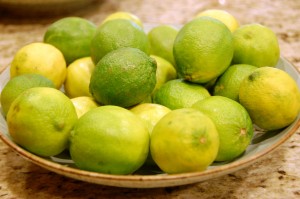
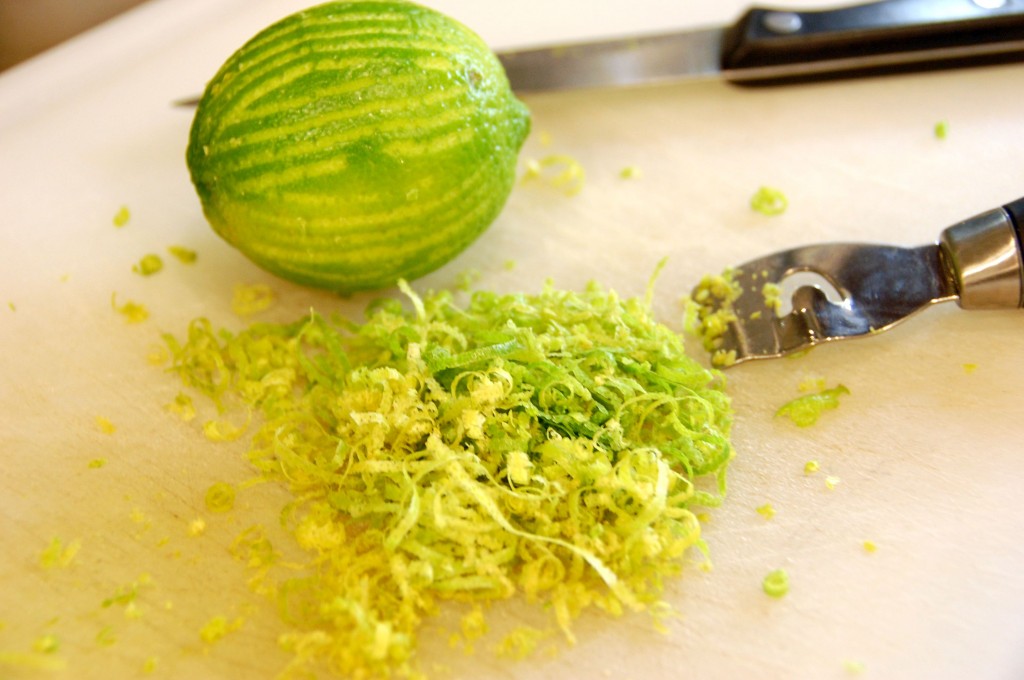
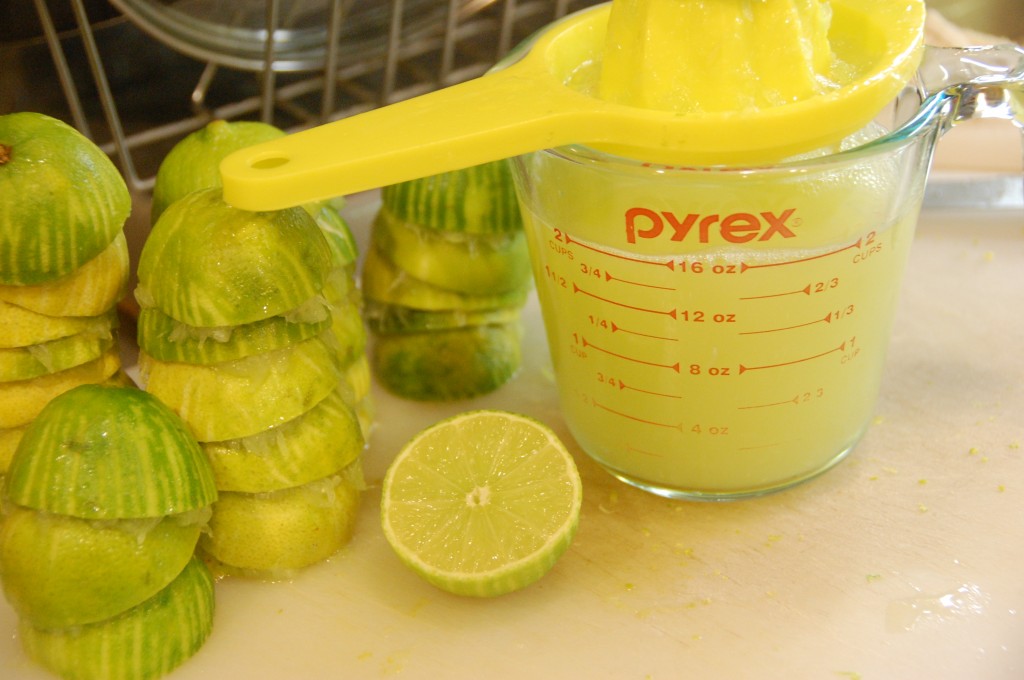
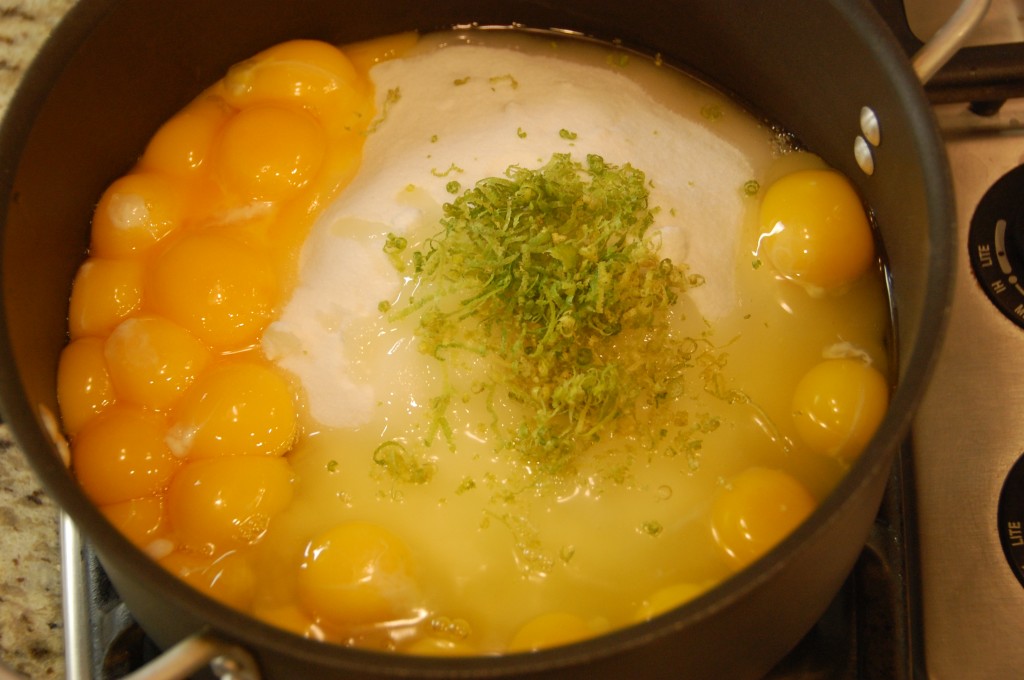
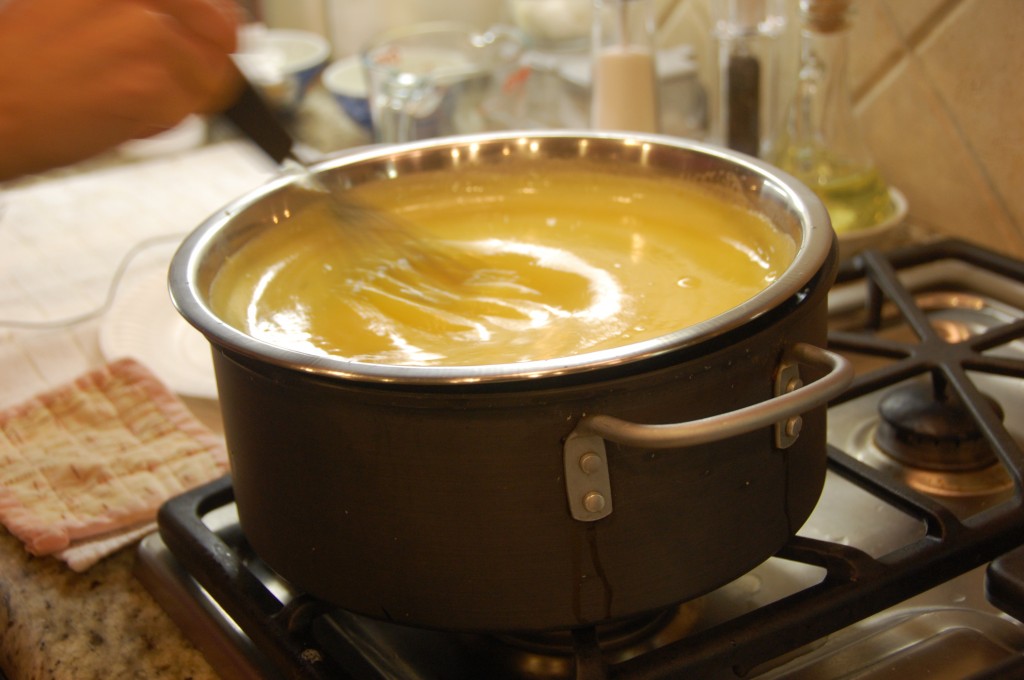
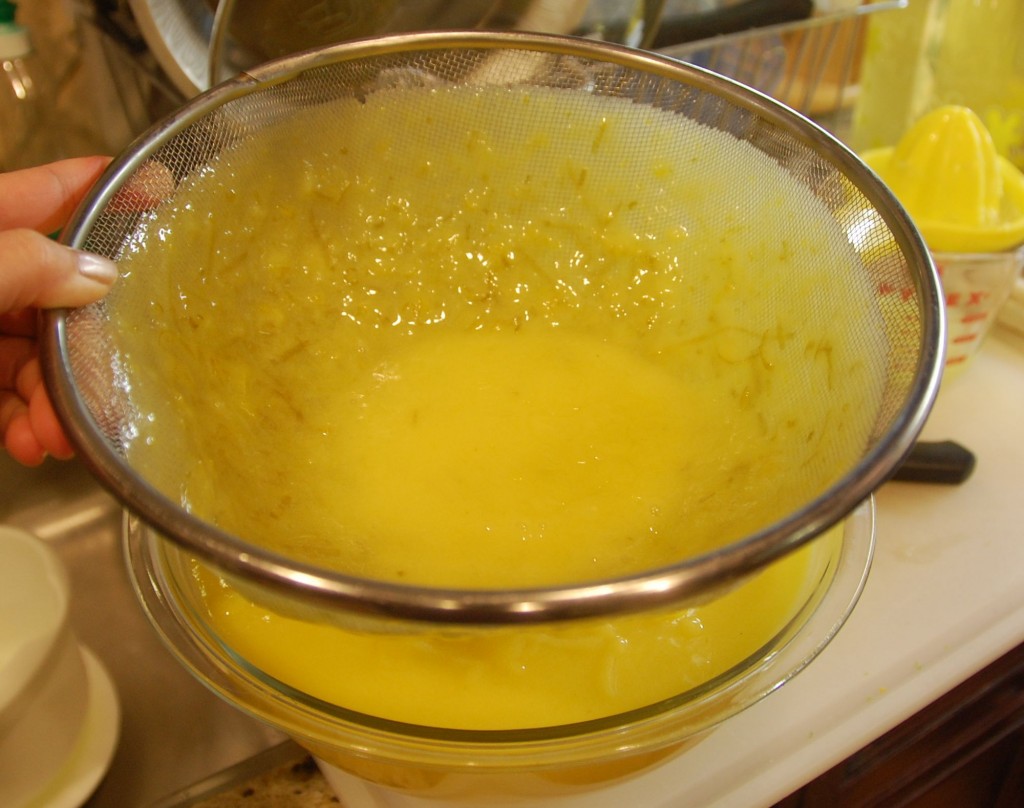
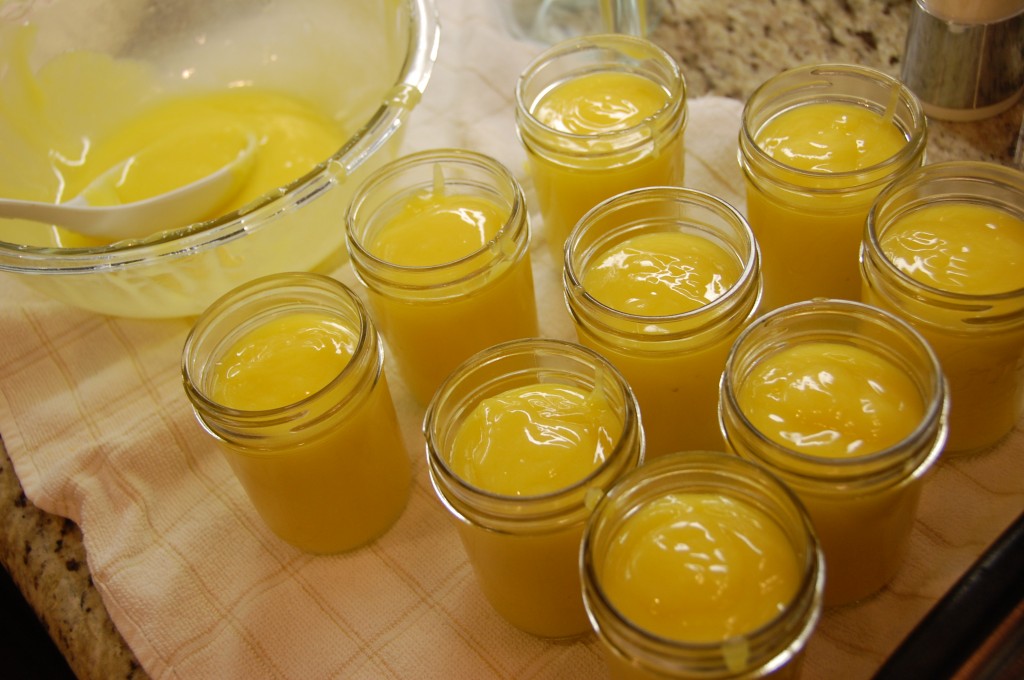
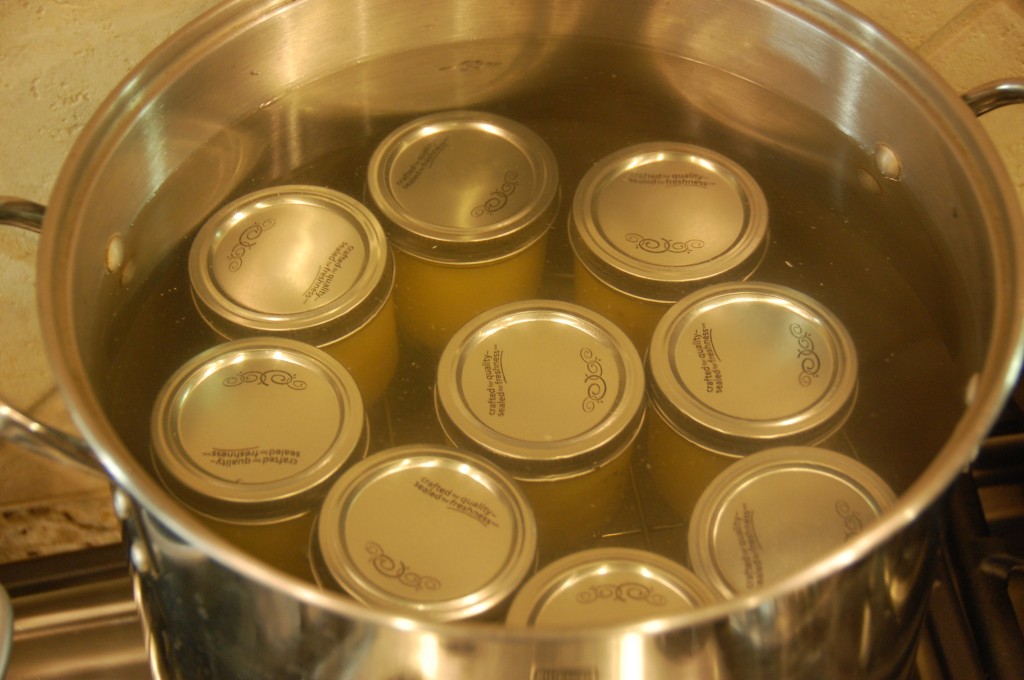
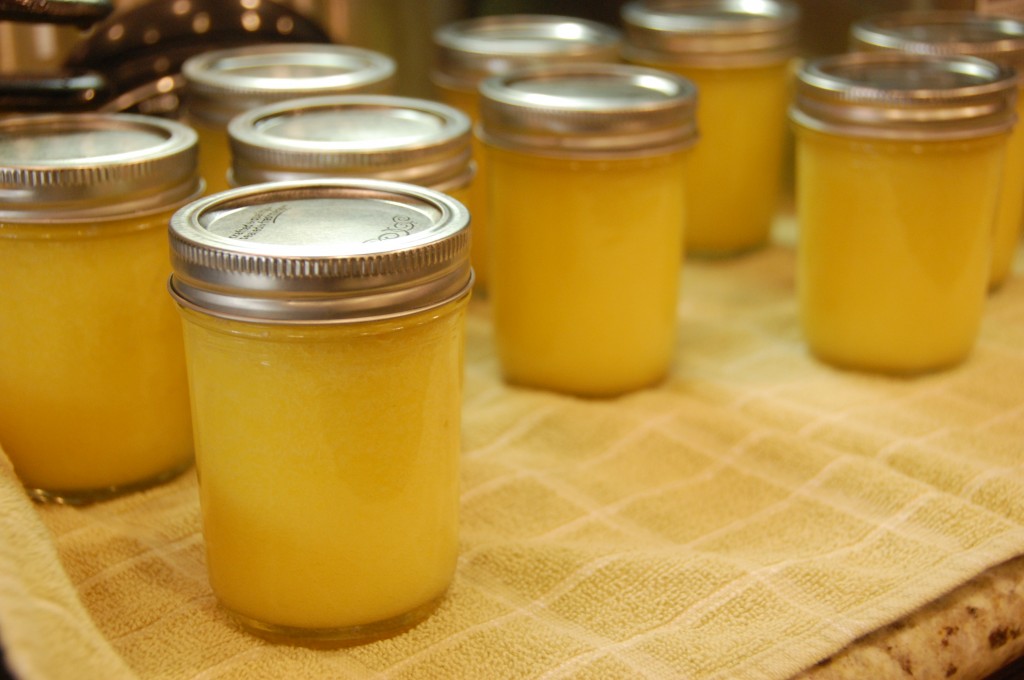


YUMMM! I made lemon curd to fill cupcakes and macarons a few months ago. I’ve never canned anything before and I don’t know that I need 4.5 pints of it but it would make a great gift! *plots*
Yes, that was my thought as well… gifts… or having a bunch of lemon or lime curd on hand for quick cake/pie fillings, or throwing together a dessert at the last minute. You can cut this recipe in half though (I’ve done it before) and make about 4-5 half pint jars worth of lemon curd.
We have a bountiful Meyer lemon tree and I was looking for recipes when I stumbled on this one.
The curd is incredibly tasty but somehow only yielded 3 half pints in my hands.
Anyway I plan to make more to give as Christmas gifts.
This is wonderful! I love making my own lemon curd but didn’t know that I could can it. I send out gift baskets for Christmas with homemade jams (strawberry, strawberry rhubarb, apricot and pear)along with homemade soaps and candles. This year I’ll definitely be adding lemon curd and lime curd. Any more ideas for homemade items for a gift basket? I would love to hear.
Hi Margaret! Homemade gift baskets for Christmas sound like a wonderful idea!
Limoncello is always a great homemade gift to give – have you ever tried it?
http://www.the350degreeoven.com/2011/08/fruit/homemade-limoncello/
Layered cookie mixes are always a hit… you could make a holiday version of “Coyboy Cookie Mix” using appropriately colored M&M candies also:
http://www.the350degreeoven.com/2011/02/cookies-bars/kowgirl-cookie-mix-cowgirl-cookie-mix/
(Just make sure you use quart sized Mason jars, and pack the flour and other ingredients down really well so that everything fits.)
Thank you for sharing this great recipe! I have made both the lemon and the lime now and they are both delicious! I made the lime today and added 3 tablespoons of freshly grated ginger, a vanilla bean, and 2 tablespoons fresh rose water. It came out great.
That sounds like an amazing combo… ginger + vanilla + rose water… yum! Glad it worked out for you!
Can you freeze the Lemon Curd?
Yes, you can – just not in glass jars. I would use clean plastic freezer jars (cool the lemon curd first, then put it into clean plastic storage jars, then freeze immediately. Defrost a day ahead of time in the refrigerator – you may need to stir the lemon curd if it separates, but otherwise it should be fine). Ball makes pretty good 8oz freezer storage jars:
Ball Plastic Freezer Jars
This looks delicious! This would be perfect to take to my sister in laws bridal shower! Do you know if you can buy lemon curd already made from the grocery store? I’m sure it’s not even close to the taste of freshly homemade lemon curd but I don’t think I’ll have time to make it fresh. Thanks for sharing this recipe!
Yes, you can usually buy lemon curd in the “gourmet” section of your supermarket, or at specialty markets like Trader Joe’s.
Yes, you can buy lemon curd in the gourmet section of your supermarket, or at specialty stores like Trader Joe’s.
Can u use Splenda instead of sugar for people who are diabetic?
Does it jell as well?
I’m not sure. I have never tried. When making jellies/jams/curd, sugar plays additional roles other than sweetening. Sugar helps to preserve, and helps provide the texture and consistency. You might try making a small 1/2 or 1/4 batch with splenda to see how it turns out for you – I would NOT advised you to home-can any recipe for lemon curd that deviates from the National Center for Home Food Preservation’s “safe” recipe.
I would like to make these for a party. Can I make the crusts the day before and fill the day of the party?
This is a recipe for lemon curd that you are commenting on. Do you mean you are making lemon curd TARTS or tartlets (see links below)?
http://www.the350degreeoven.com/2011/06/pastries-pies/flower-shaped-mini-lemoncurd-tarts/
http://www.the350degreeoven.com/2013/09/pastries-pies/homemade-mini-tartlet-desserts-how-to-make-mini-tarts/
If so, then yes – you can make the shells a day ahead of time and fill before the party.
Is this recipe safe to can? It is my understanding you cannot can dairy products, like eggs.
If you follow the National Center for Home Food Preservation’s “safe” recipe for home canned lemon curd, published by the University of Georgia… according to them, it is safe to can. Please note that their recipe specifies the use of bottled lemon juice for a known level of acidity.
http://nchfp.uga.edu/publications/nchfp/factsheets/lemon_curd.pdf
So that recipe of the “safe” way to do it is calling for bottles but yours is fresha nd you havent had a problem? I’m just making sure that you have made this multiple times.
The safe way is to use the National Center for Home Food Preservation’s “safe” recipe for home canned lemon curd, published by the University of Georgia. The reason for this is because acidity level can vary greatly in lemons, and you need to make sure you have the right % of acid. I make mine with fresh lemons… but I know that the variety I use is highly acidic. I wouldn’t take the chance if you aren’t sure (for canning).
If you are going to use your lemon curd right away, or keep it refrigerated – then you can use any lemons you want (just try to use the curd within 2 weeks).
I want to make a cranberry orange curd for Christmas, but I want to can it. Can I do it in a pressure canner, or is there a way to up the acidity so it can be wayer-bath canned?
Sorry, I’m not too familiar with pressure canning, and the only recipe I know of for “Safe” canned lemon curd is the National Center for Home Food Preservation’s recipe:
http://nchfp.uga.edu/how/can_02/lemon_curd.html
Can you share the cranberry orange curd recipe please?
That combo sounds divine! Thanks so much!
Never made anything like this before, but just couldn’t find any in store, so …how hard can it be?
Made it and it was so easy and the result is delicious! I’m sure so much better than any store bought. I cut the recipe to a third, just needed a little to make the tartlets!
Yay! Glad to hear it worked out for you!
I tried to can the lemon curd today somewhat following this recipe. I used less sugar than the recipe and used Perfect Puree Lemon concentrate instead of fresh juice. Everything seemed fine until the canning process. Te heat killed the emulsion and the butter seperated and is laying on top of the custard. It is ugly! The remaining curd I did not can, I just froze it. I suppose after a couple of weeks I will take a jar and try to re-emulsify it??? I am not sure if the 25 minute cook time is needed? The Ph levels have to be good with all of the acid in it.
Hmmm… not sure what happened. When I make canned lemon curd, this hasn’t happened to me, but I only process for 15 minutes, as indicated in step 7. A 25 minute processing time would only be necessary if you are at over 6,000ft in elevation (are you?). I would caution you though not to alter the recipe because sugar helps to act as a preservative, and according to the National Center for Home Food Preservation – this is the only “safe” ratio/recipe.
http://nchfp.uga.edu/publications/nchfp/factsheets/lemon_curd.pdf
Yes sugar is a preservative so is the acid in the lemon juice & if ph levels are not in line you can always add citric acid to out it into safe levels. Providing the ph is less than 4.4 you are considered acidic but I tend to out mine in the 3.0 – 3.5 depending on product
OK… I’m not trying to debate anything with you. Chemistry, microbiology, and safe home water-bath canning do have some overlap but I think we are over-simplifying here a bit.
Water bath canning will not “kill” Clostridium botulism – acid doesn’t “kill” C. botulism either, but it does help prevent their spores from germinating if the environment is acidic enough – so it is good that your pH is low. But please keep in mind that C. botulism is not the only microorganism that can contaminate or spoil food, making it unsafe to consume. There are some bacteria, for example, that are acidophiles and will thrive in a highly acidic environment – hence the double insurance with the acid + adequate water-bath processing step. I would NOT reduce the water bath processing time below the National Center for Home Food Preservation’s guidelines for safety reasons. The combination of high acid + proper water bath canning processing time does not guarantee that your food will not spoil, but together, they reduce the risk significantly.
Now regarding the “25 minute processing time” that you have referred to in my recipe – I’m not sure where you got that from unless you are at a very high elevation (over 6000 ft). I did recommend a 15 minute, NOT a 25 minute, processing time for most of us who live within 1000 ft of sea level.
ETA: Also keep in mind that by decreasing the amount of sugar called for in the recipe, you have changed the recipe. This could also be why you had a separation of layers after canning. Just a thought.
@ Bev farran. If you are talking about preserves, jellies/jams artificial sweeteners will work but you would need Sure Jell. Special pectin that uses less or no sugar.
Just checked the ph level with Hannah Instruments tester and the ph came up 3.1
Sounds acidic enough to eliminate 25 minute bath. Just bath long enough to seal kids.
Again, the processing time recommended by the National Center for Home Food Preservation is 15 minutes for those under 1000 ft, 20 minutes for 1001-6000ft, and 25 minutes for those over 6000ft in elevation. By altering the recipe and processing times – this may not produce a “safe” home canned lemon curd. Be careful.
http://nchfp.uga.edu/publications/nchfp/factsheets/lemon_curd.pdf
Lemon Curd sounds awesome. Never had it before here in South Africa. I have a tree though and going to try make it.
Mika, I was so excited to see this recipe. I know recipe said bottled lemon juice but you prefer fresh. I have a Meyer lemon tree. Did you use Meyer lemons as well.
Meyer lemons are less acidic, so they make wonderful tasting lemon curd – but probably not safe to home can!
I am thrilled to have found your recipe! I love lemon curd but would much prefer to can my own. Would you mind sharing what variety of lemons you used to ensure the right acid content? And can I add citric acid if mine are not acidic enough?
Hi Carolyn, I normally use Eureka lemons. However, even within a variety, acidity levels can vary, and the only “safe” method is to use bottled lemon juice. It might be safer to freeze your lemon curd rather than canning it to be on the safe side.
Lord knows, i cannot follow a recipe to save my life. I tried making this, but it appears i did not cook the mixture long enough, as it did not look as thick as yours did in the picture. This i did not notice until after i canned and put in for processing. It will be interesting to see tomorrow how it turns out. Fortunately, i have a large lemon tree with loads of lemons, so i can give it another try..
You might find that your curd thickens a little as it cools. If it wasn’t thick enough, then you can always use your lemon curd as a delicious sauce or syrup for pancakes, waffles, ice creams, etc.
I normally use extra large eggs from Costco (eggs will help thicken the curd), so if you are using smaller eggs you might add an extra egg or two next time.
Thank you. I have since made a second batch, took my time, doubled and tripled following the directions, and ….. the batch turned out perfect! I am so freakin’ proud of myself. Lol.
Yay! So glad it worked out for you!
Did the lime curd today & added a shot of Galliano. Wow! Delicious! I think I will try freezing in jars when I do my lemon curd since I have a Meyer lemon tree that produces year around. Thanks for the site!
This recipe doesn’t work, I tried it twice. the mixture never coagulates, don’t use this recipe unless you want to waste a lot of time and money
I’m sorry the recipe didn’t work for you! But it *does* work, and it is actually based on a tried and true recipe from the National Center for Food Preservation at the University of Georgia:
http://nchfp.uga.edu/publications/nchfp/factsheets/lemon_curd.pdf
I would double check your ingredients and make sure you didn’t accidentally skip a step or skip something. For example, the recipe calls for 8 whole eggs + 14 egg yolks. If you read through it quickly and mistakenly didn’t use BOTH, then it could cause a problem.
Also keep in mind that the texture of lemon curd will often be more “loose” when warm, and be “stiffer” upon cooling, chilling, or refrigeration.
It is delicious, my husband was cleaning up (licking) the bowl,pot, spatula, everything! He said “you can’t give all those jars away, save some for us!”